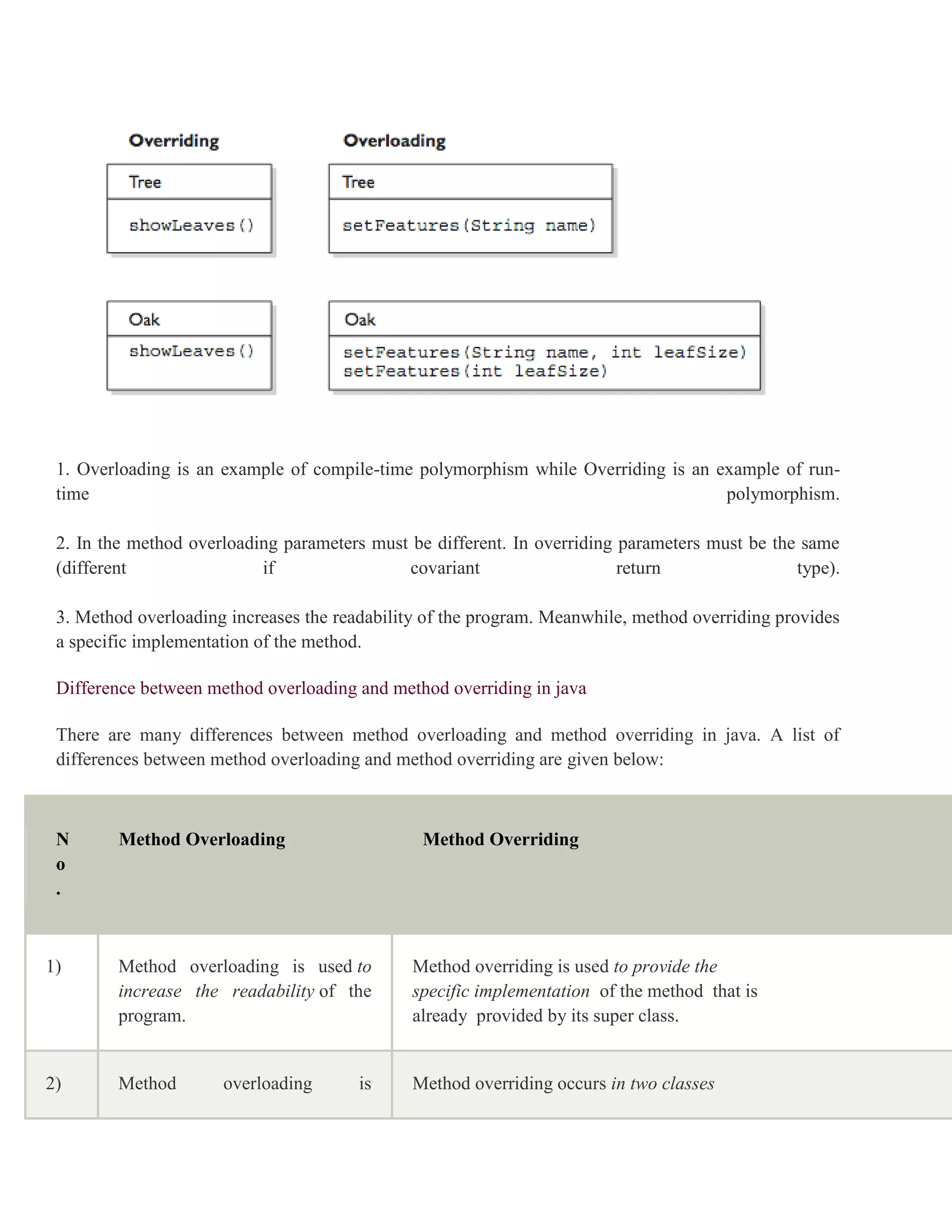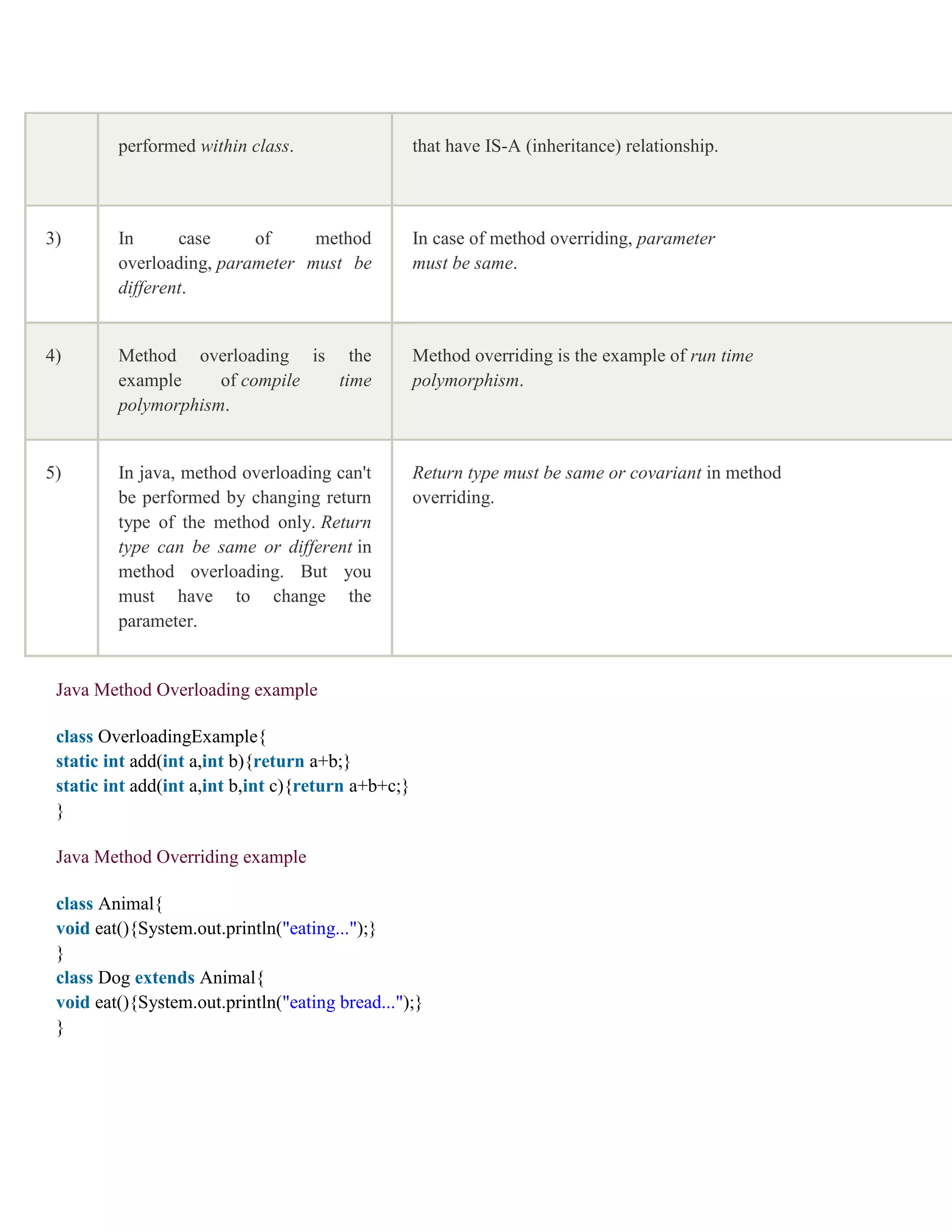This document provides an overview of the history and features of the Java programming language. It discusses that Java was originally developed by Sun Microsystems in 1991 and was designed to be portable, simple, secure, and robust. Some key features of Java include being object-oriented, platform independent through bytecode compilation, having automatic memory management, and being well-suited for web and internet applications through applets. The document also compares Java to C and C++, noting differences like Java not supporting pointers or multiple inheritance. It describes how Java works with web browsers and HTML to enable interactive content on web pages through applets.
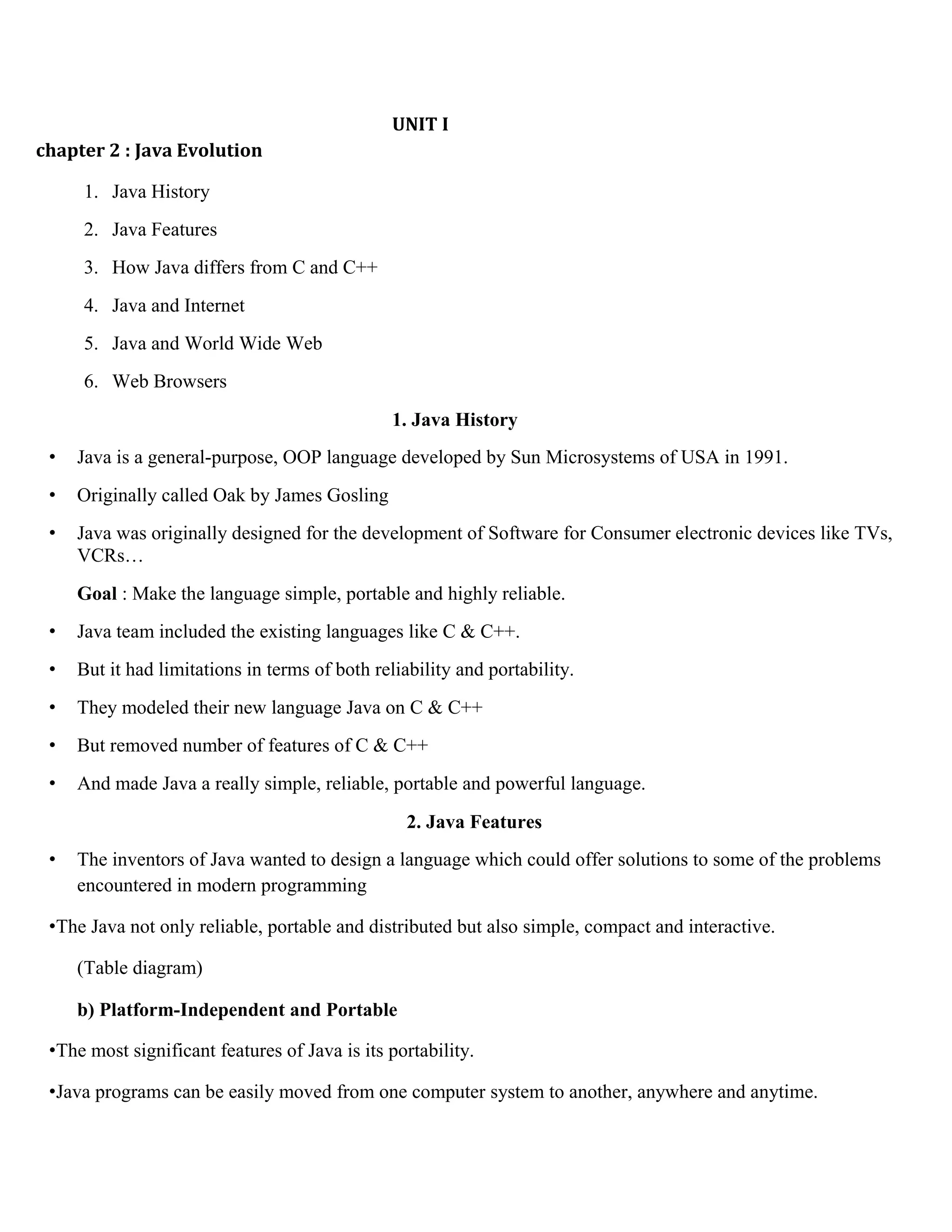

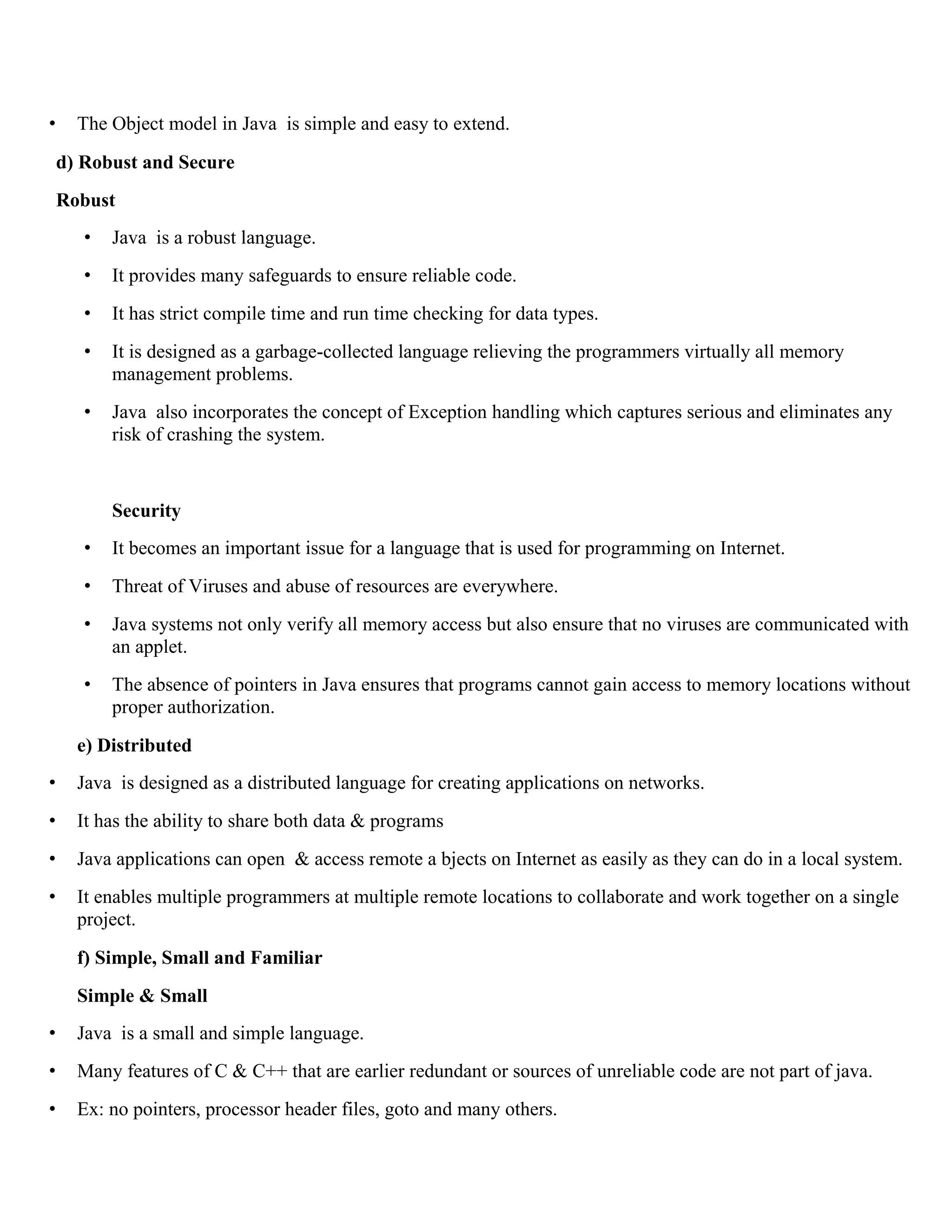

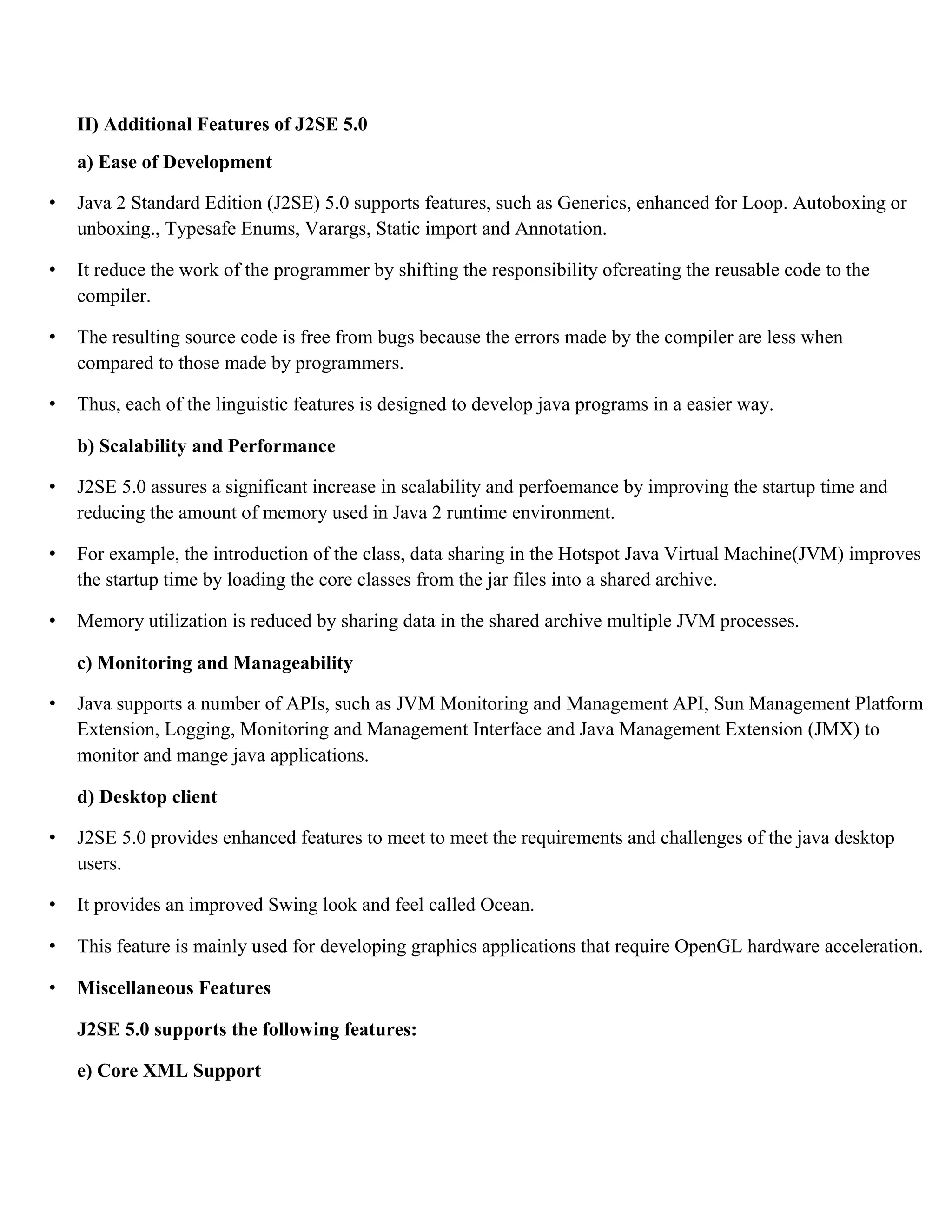
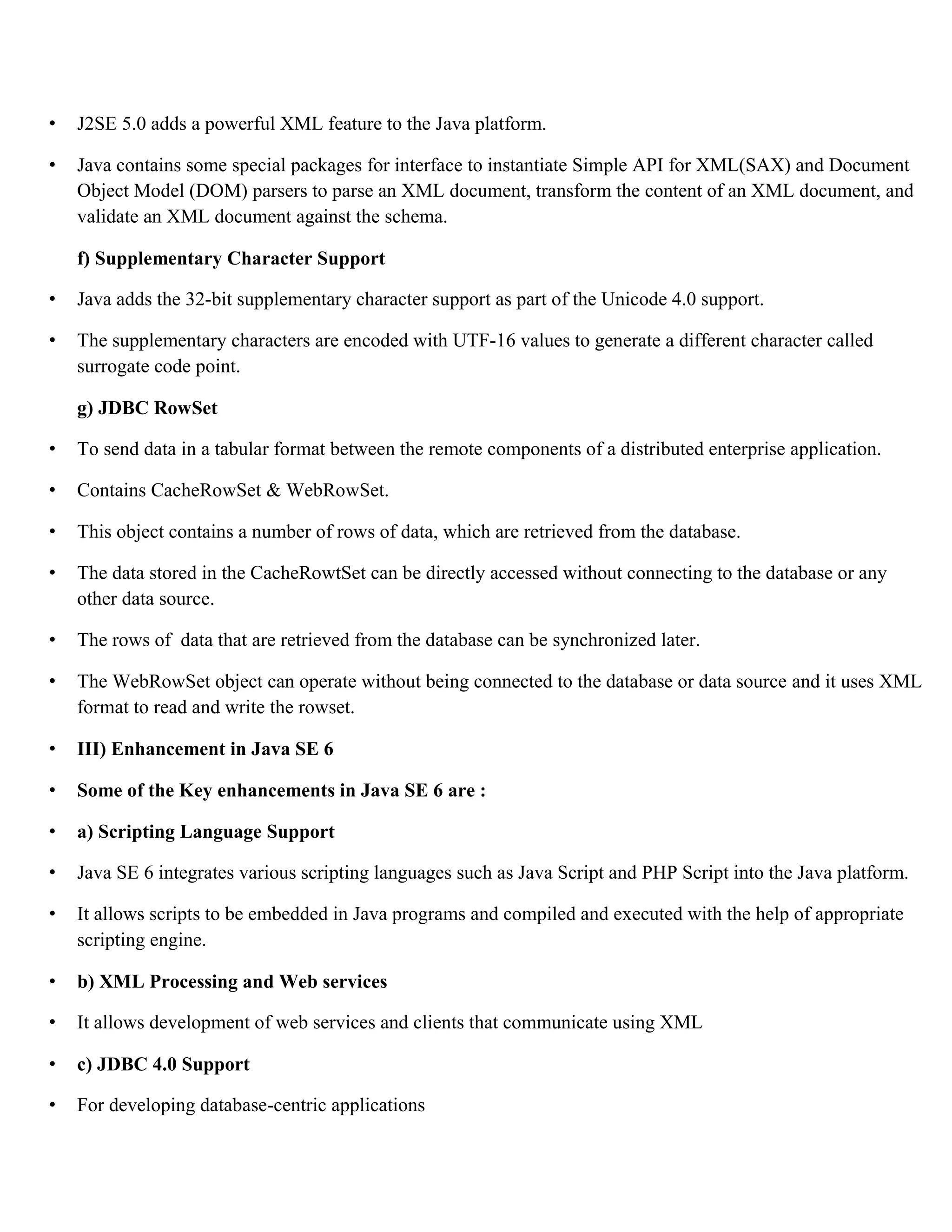
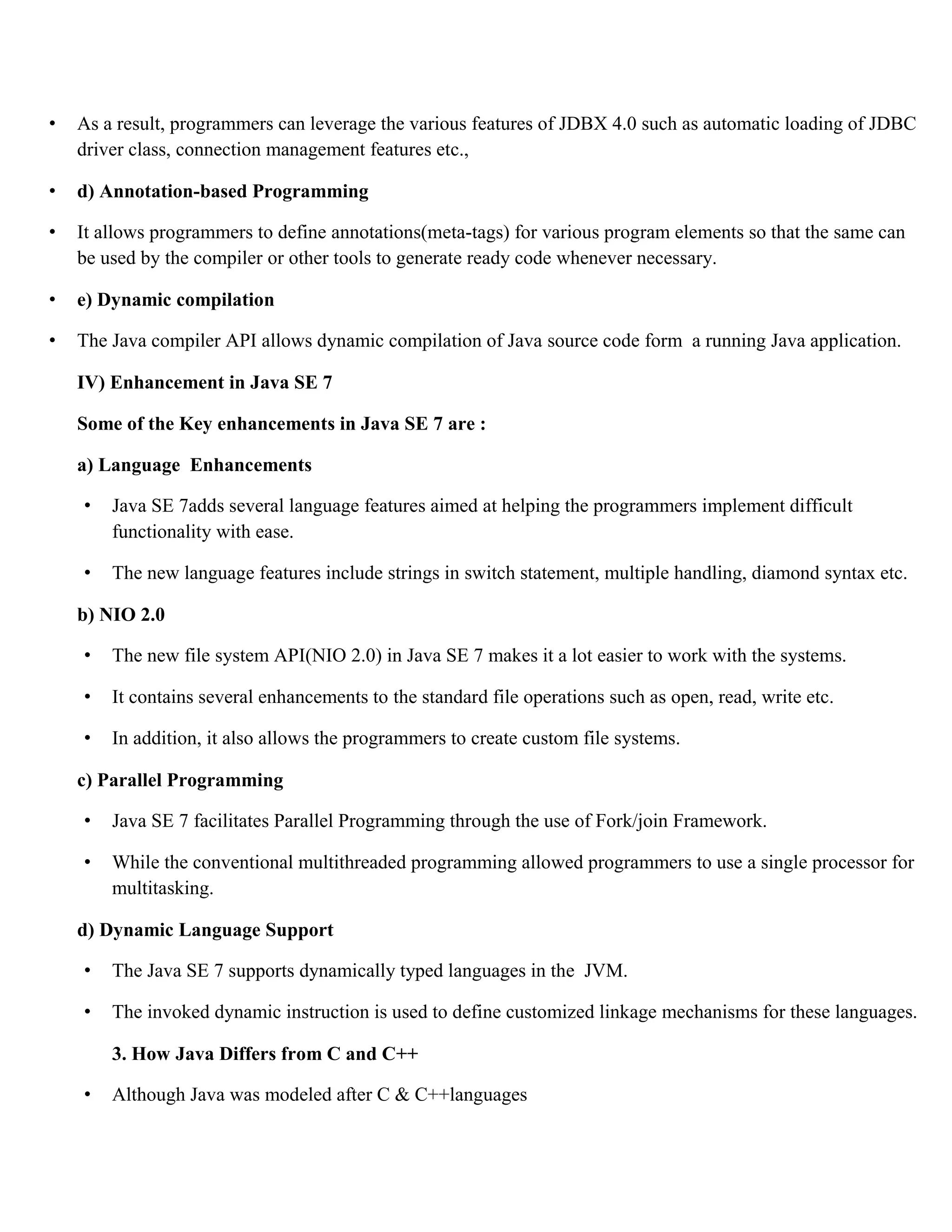
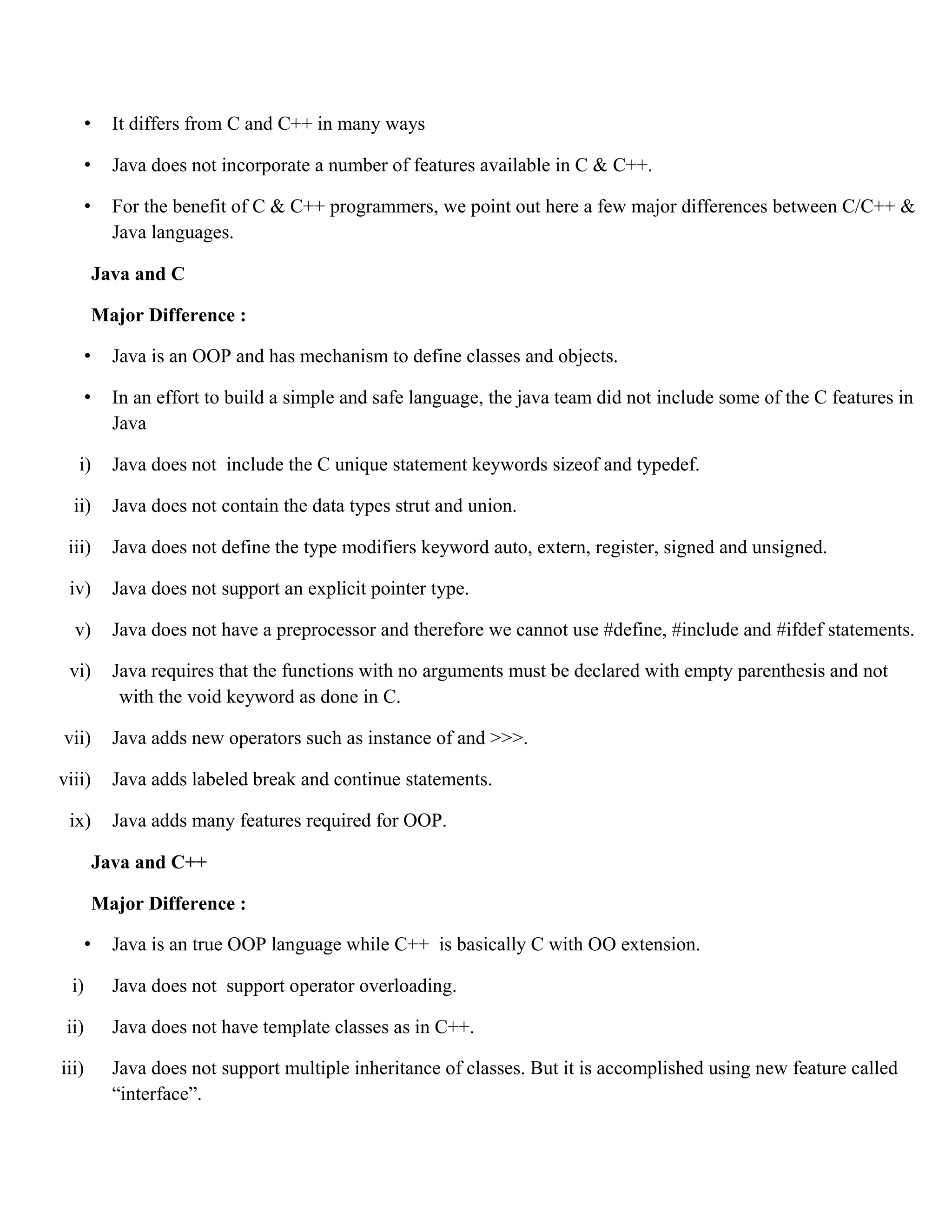



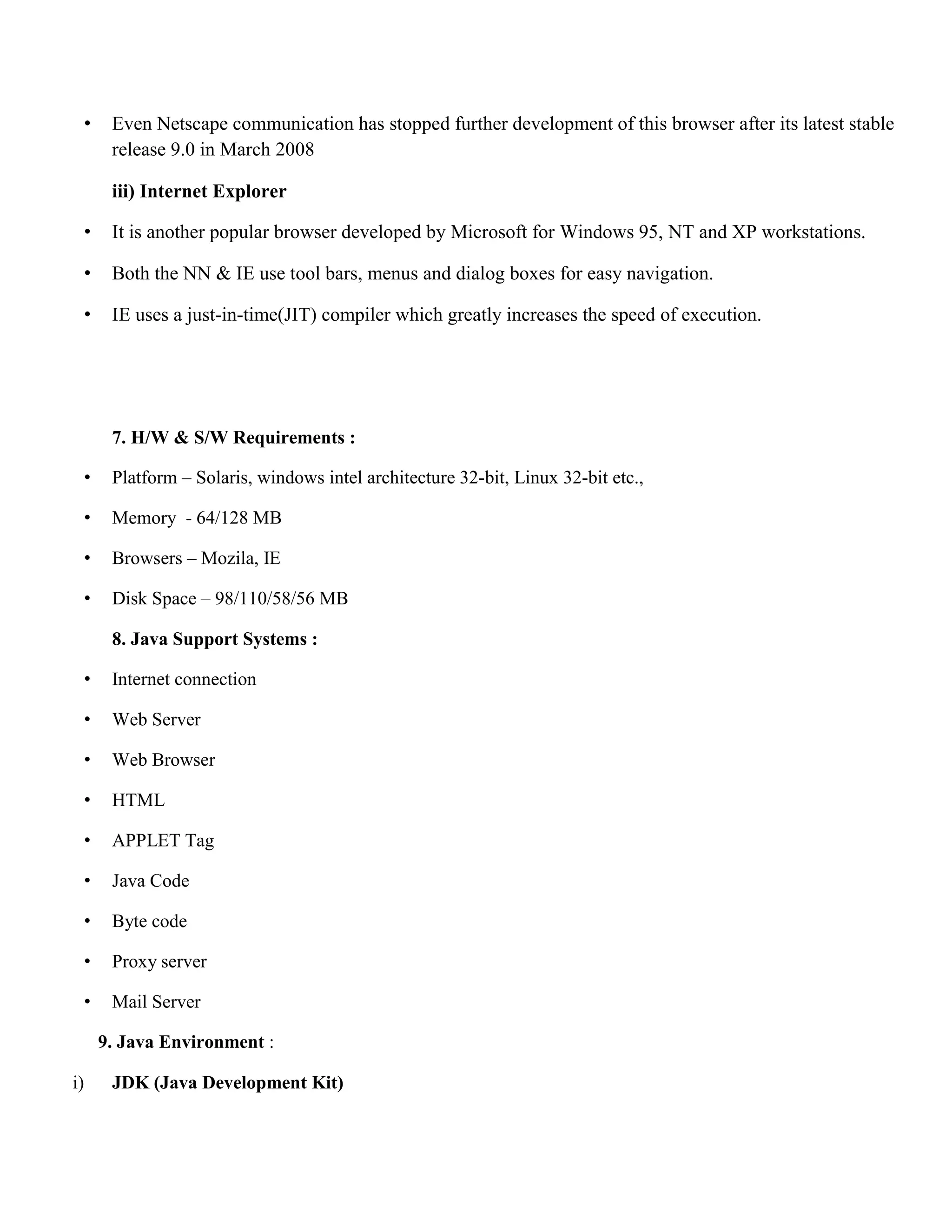
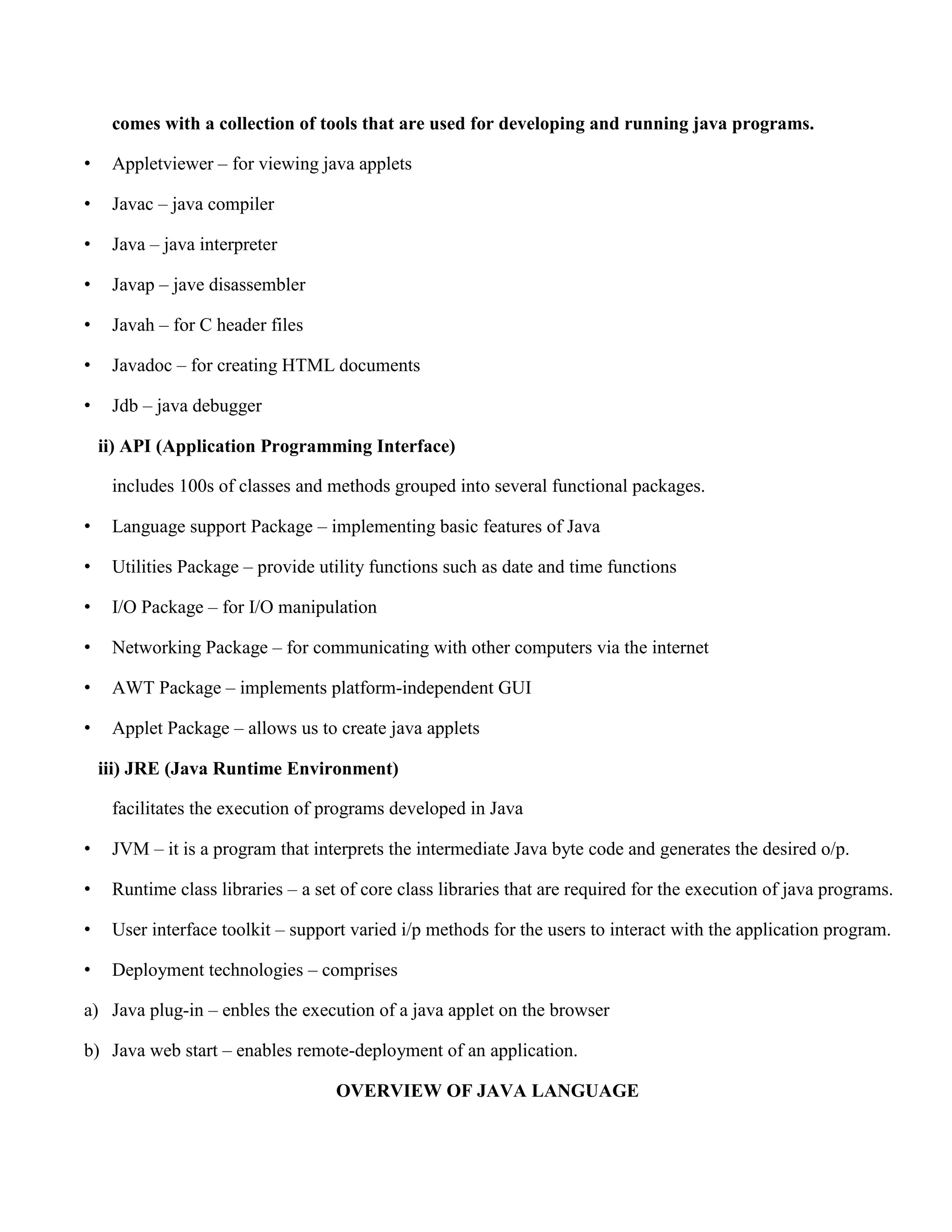
![To create a simple java program, you need to create a class that contains main method. Let's understand the requirement first. REQUIREMENT FOR HELLO JAVA EXAMPLE: For executing any java program, you need to • install the JDK if you don't have installed it, download the JDK and install it. • set path of the jdk/bin directory. • create the java program • compile and run the java program CREATING HELLO JAVA EXAMPLE : class Simple{ public static void main(String args[]){ System.out.println("Hello Java"); } } save this file as Simple.java To compile : javac Simple.java To execute :java Simple JAVA PROGRAM STRUCTURE • Let’s use example of HelloWorld Java program to understand structure and features of class. • This program is written on few lines, and its only task is to print “Hello World from Java” on the screen. Refer the following picture. 1.“PACKAGES”:](https://image.slidesharecdn.com/javafull-231001024002-6ff00f11/75/java-full-docx-14-2048.jpg)
![2. “PUBLIC CLASS HELLOWORLD”: 3. COMMENTS SECTION: 4. “PUBLIC STATIC VOID MAIN (STRING [ ] ARGS)”: 5. SYSTEM.OUT.PRINTLN("HELLO WORLD FROM JAVA") JAVA TOKENS • A Java program is basically a collection of classes. • A class is defined by a set of declaration statements and methods containing executable statements. • Most statements contain expressions, which describe the actions carried out on data. • Smallest individual unit in a program are known as tokens. • The compiler recognizes them for building up expressions and statements. 5 Types of Tokens i. Reserved keywords ii. Identifiers iii. Literals iv. Operators v. Separators Diagram JAVA CHARACTER SET • The smallest units of Java language are the characters used to write Java tokens. • These characters are defined by the Unicode character set. • Emerging standard that tries to create characters for a large number of scripts worldwide. • The Unicode is a 16-bit character coding system and currently supports more than 34,000 defined characters. • That is derived from 24 languages](https://image.slidesharecdn.com/javafull-231001024002-6ff00f11/75/java-full-docx-15-2048.jpg)

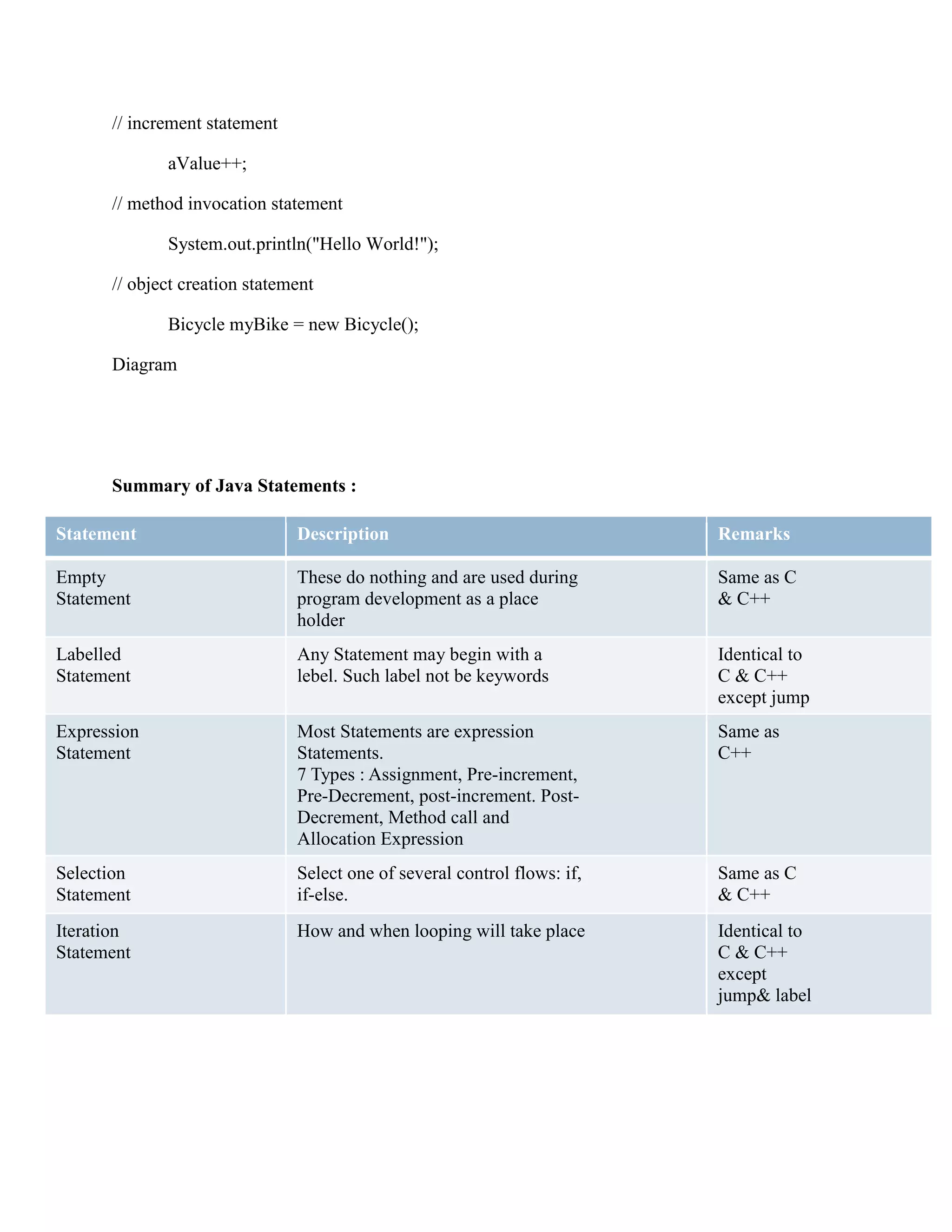




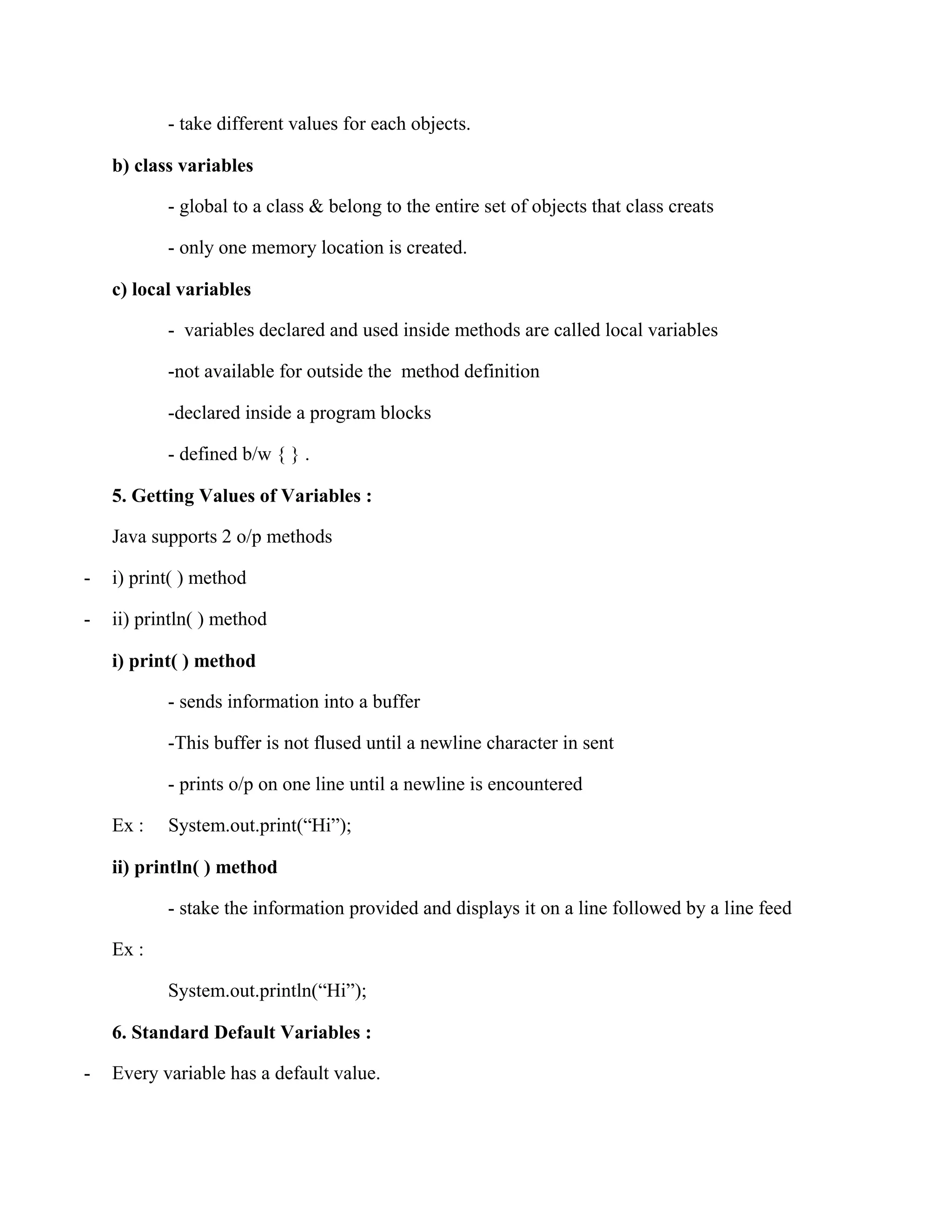

![- the conversion of the assigned value automatically known as automatic-type conversion Ex : byte b =10; int a =b; From To byte Short, char, int, long, float, double short Int, long, float, double char Int, long, float, double int long, float, double long float, double float double VARIABLE ARGUMENT (VARARGS): The varrags allows the method to accept zero or muliple arguments. Before varargs either we use overloaded method or take an array as the method parameter but it was not considered good because it leads to the maintenance problem. If we don't know how many argument we will have to pass in the method, varargs is the better approach. ADVANTAGE OF VARARGS: WE DON'T HAVE TO PROVIDE OVERLOADED METHODS SO LESS CODE. SYNTAX OF VARARGS: The varargs uses ellipsis i.e. three dots after the data type. Syntax is as follows: 1. return_type method_name(data_type... variableName){} SIMPLE EXAMPLE OF VARARGS IN JAVA: 1. 2. class VarargsExample1{ 3. 4. static void display(String... values){ 5. System.out.println("display method invoked "); 6. } 7. 8. public static void main(String args[]){ 9.](https://image.slidesharecdn.com/javafull-231001024002-6ff00f11/75/java-full-docx-24-2048.jpg)
![10. display();//zero argument 11. display("my","name","is","varargs");//four arguments 12. } 13. } 14. Test it Now Output:display method invoked display method invoked ANOTHER PROGRAM OF VARARGS IN JAVA: 1. 2. class VarargsExample2{ 3. 4. static void display(String... values){ 5. System.out.println("display method invoked "); 6. for(String s:values){ 7. System.out.println(s); 8. } 9. } 10. 11. public static void main(String args[]){ 12. 13. display();//zero argument 14. display("hello");//one argument 15. display("my","name","is","varargs");//four arguments 16. } 17. } 18. Test it Now Output:display method invoked display method invoked hello display method invoked my name is varargs download this example](https://image.slidesharecdn.com/javafull-231001024002-6ff00f11/75/java-full-docx-25-2048.jpg)
![Rules for varargs: While using the varargs, you must follow some rules otherwise program code won't compile. The rules are as follows: o There can be only one variable argument in the method. o Variable argument (varargs) must be the last argument. EXAMPLES OF VARARGS THAT FAILS TO COMPILE: 1. 2. void method(String... a, int... b){}//Compile time error 3. 4. void method(int... a, String b){}//Compile time error 5. EXAMPLE OF VARARGS THAT IS THE LAST ARGUMENT IN THE METHOD: 1. 2. class VarargsExample3{ 3. 4. static void display(int num, String... values){ 5. System.out.println("number is "+num); 6. for(String s:values){ 7. System.out.println(s); 8. } 9. } 10. 11. public static void main(String args[]){ 12. 13. display(500,"hello");//one argument 14. display(1000,"my","name","is","varargs");//four arguments 15. } 16. } 17. Test it Now Output:number is 500 hello number is 1000](https://image.slidesharecdn.com/javafull-231001024002-6ff00f11/75/java-full-docx-26-2048.jpg)
![my name is varargs Varargs is a short name for variable arguments. In Java, an argument of a method can accept arbitrary number of values. This argument that can accept variable number of values is called varargs. The syntax for implementing varargs is as follows: accessModifier methodName(datatype… arg) { // method body } In order to define vararg, ... (three dots) is used in the formal parameter of a method. A method that takes variable number of arguments is called a variable-arity method, or simply a varargs method. First, let’s look at the example without using varargs: class NoVararg { public int sumNumber(int a, int b){ return a+b; } public int sumNumber(int a, int b, int c){ return a+b+c; } public static void main( String[] args ) { NoVararg obj = new NoVararg(); System.out.println(obj.sumNumber(1, 2)); System.out.println(obj.sumNumber(1, 2, 3)); }](https://image.slidesharecdn.com/javafull-231001024002-6ff00f11/75/java-full-docx-27-2048.jpg)

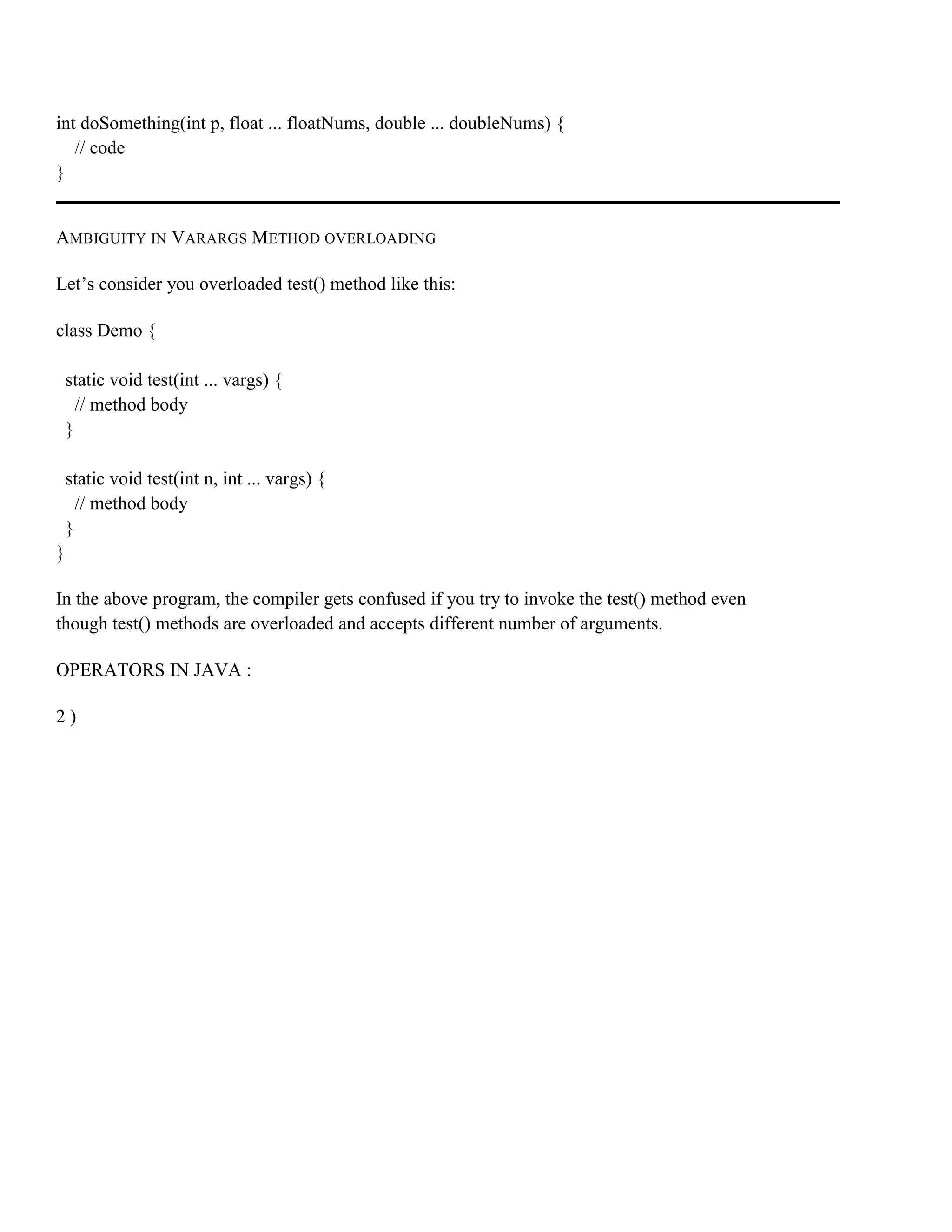


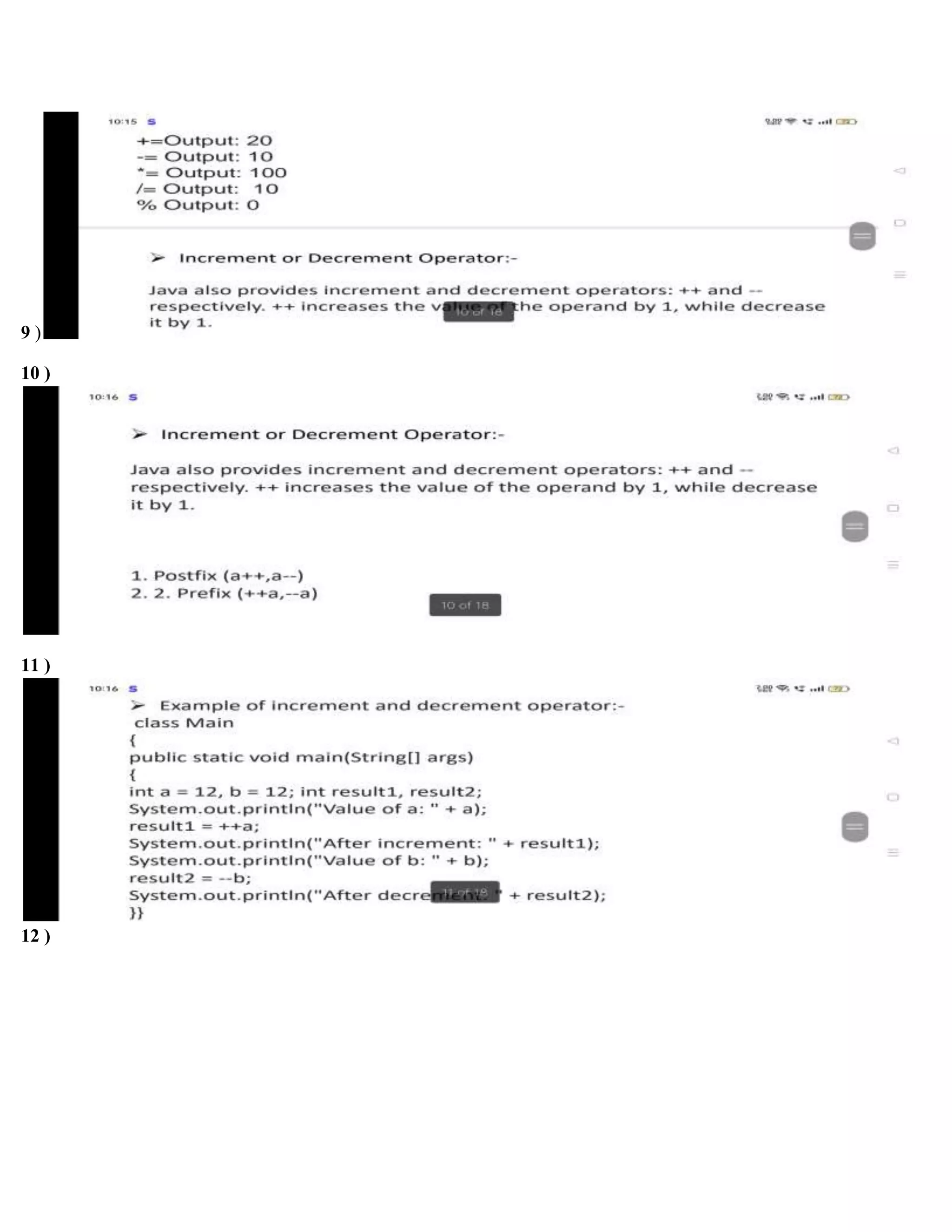

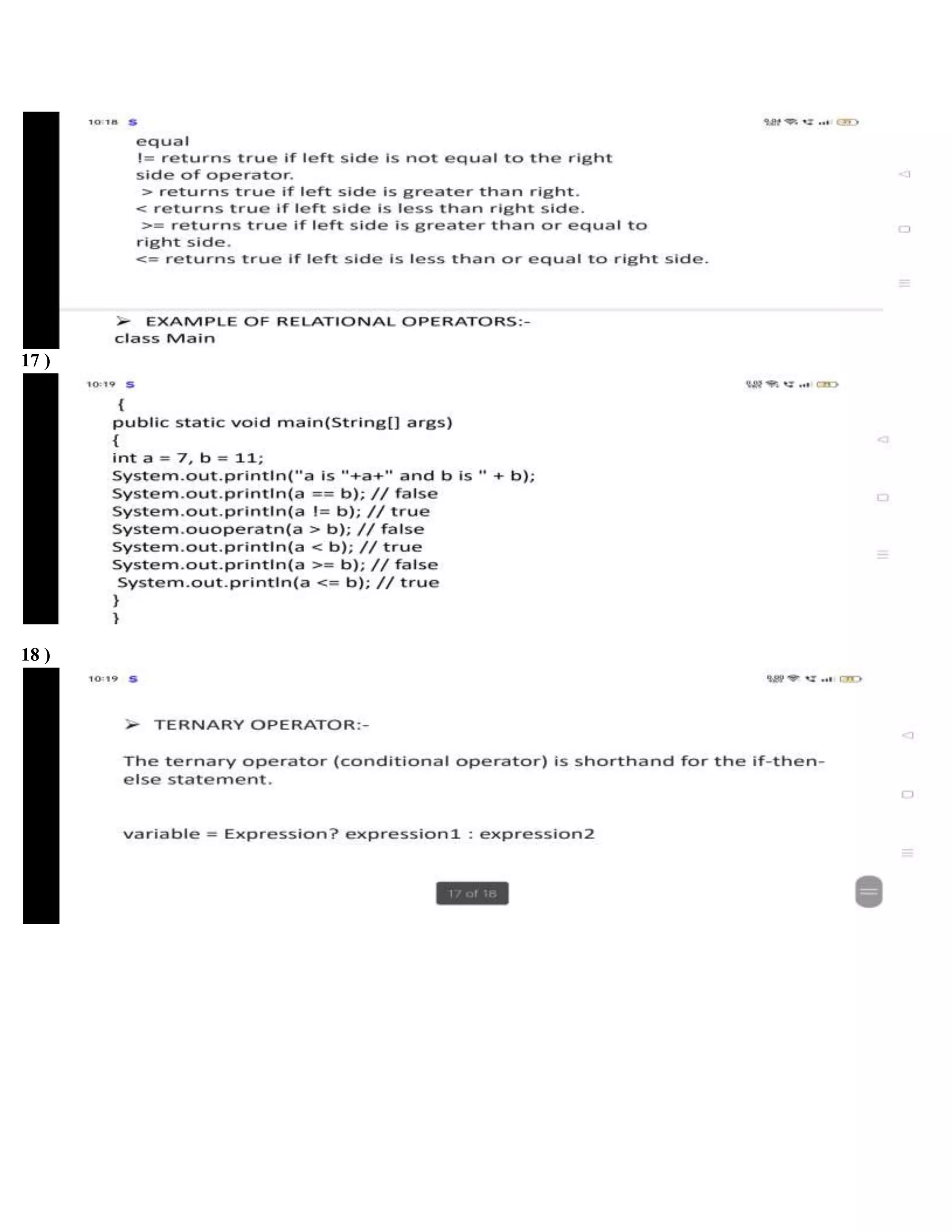
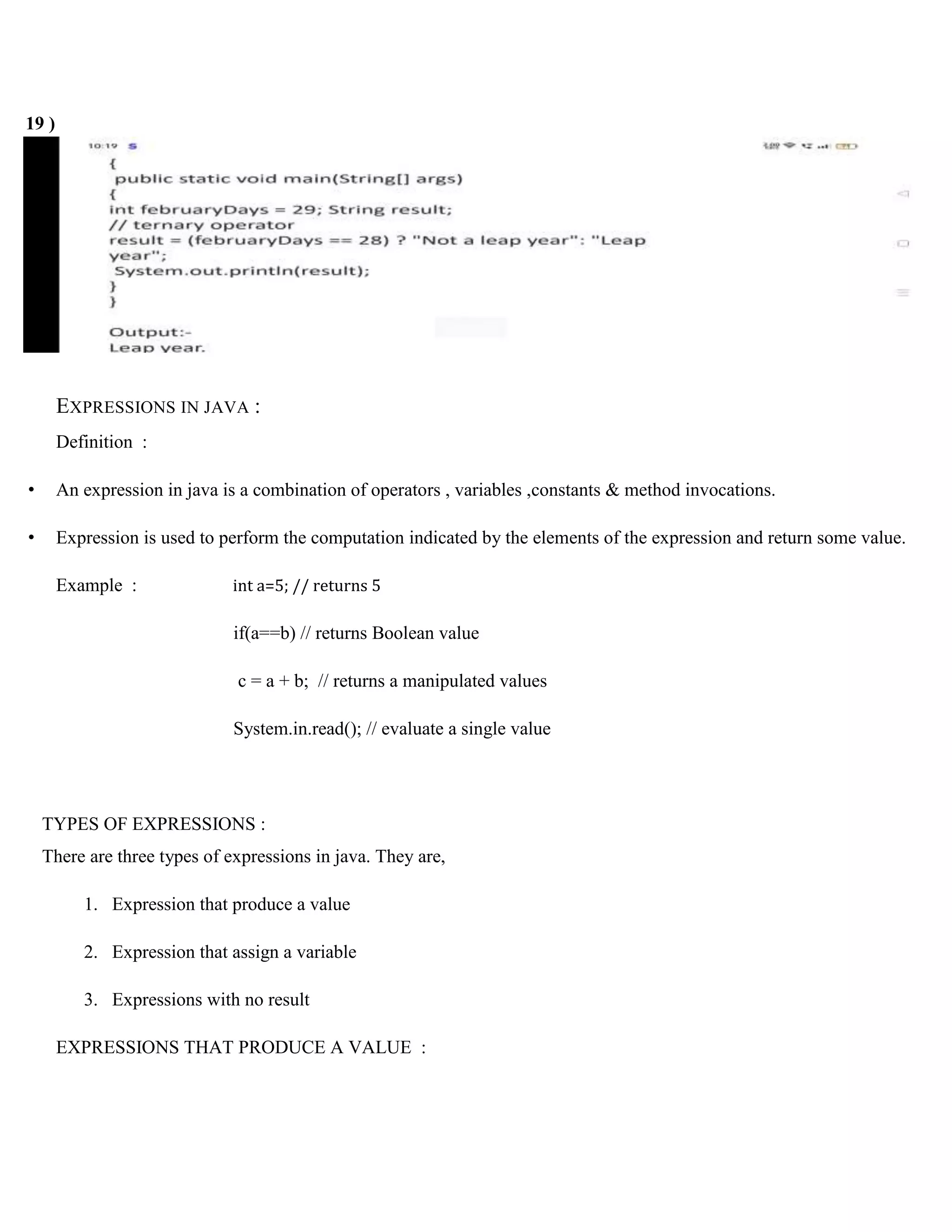


![• These variables are called instance variables because they are created whenever an object of the class is instantiated. Ex : class A { int length; Int width; } 3. FIELDS DECLARATION : • Data is encapsulated in a class by placing data fields inside the body of the class definition • Once the class type has been defined, we can create variables of that type using declarations that are similar to the basic-type declarations. • These termed as instances of classes, which are the actual objects. Syntax class classname [extends superclasname] { [ fields declaration; ] [methods declaration;] } Ex : class A { } 4. METHODS DECLARATION : • A class with only data fields & without methods that operate on that data has no life. • The objects created by such a class cannot respond to any messages. Syntax type methodname (parameter-list) { Method-body;](https://image.slidesharecdn.com/javafull-231001024002-6ff00f11/75/java-full-docx-38-2048.jpg)

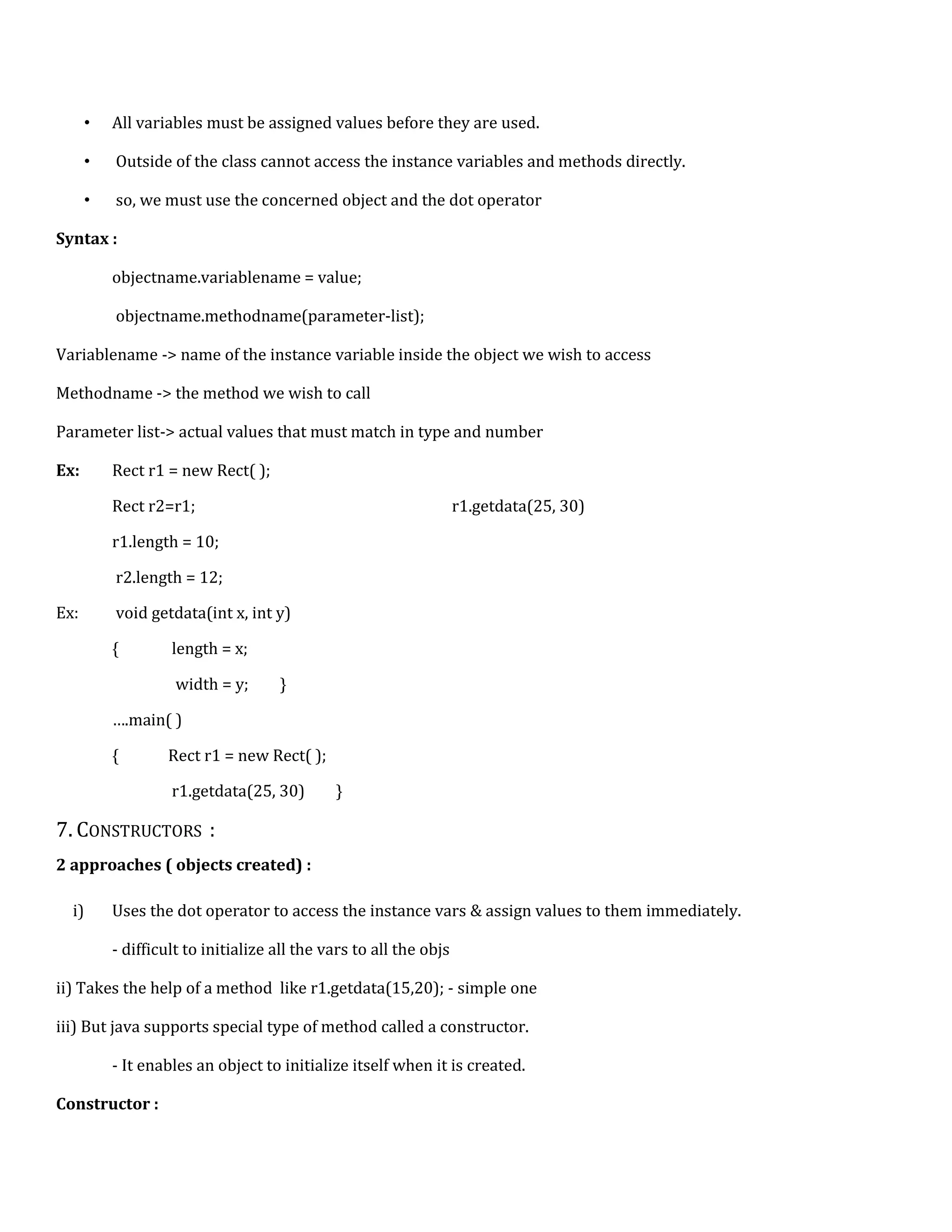


![{ public void static main(String args[]) { float a = Operation.mul(5.0,2.0); float b = Operation.div(6.0,2.0); System.out.ptintln(“a=“+a); System.out.ptintln(“b=“+b) }} 10. NESTING OF METHODS : Def : A method can be called by using only its name by another method of the same class is known as nesting of methods. class Nest { int large() { …. } class display( ) { int l = large( ); } Class Ntest { public void static main(String args[]) { ….. } INHERITANCE IN JAVA : 1. Inheritance 2. Types of Inheritance 3. Why multiple inheritance is not possible in Java in case of class? Inheritance in Java is a mechanism in which one object acquires all the properties and behaviors of a parent object. It is an important part of OOPs (Object Oriented programming system). The idea behind inheritance in Java is that you can create new classes that are built upon existing classes. When you inherit from an existing class, you can reuse methods and fields of the parent class. Moreover, you can add new methods and fields in your current class also. Inheritance represents the IS-A relationship which is also known as a parent-child relationship. Why use inheritance in java o For Method Overriding (so runtime polymorphism can be achieved).](https://image.slidesharecdn.com/javafull-231001024002-6ff00f11/75/java-full-docx-43-2048.jpg)
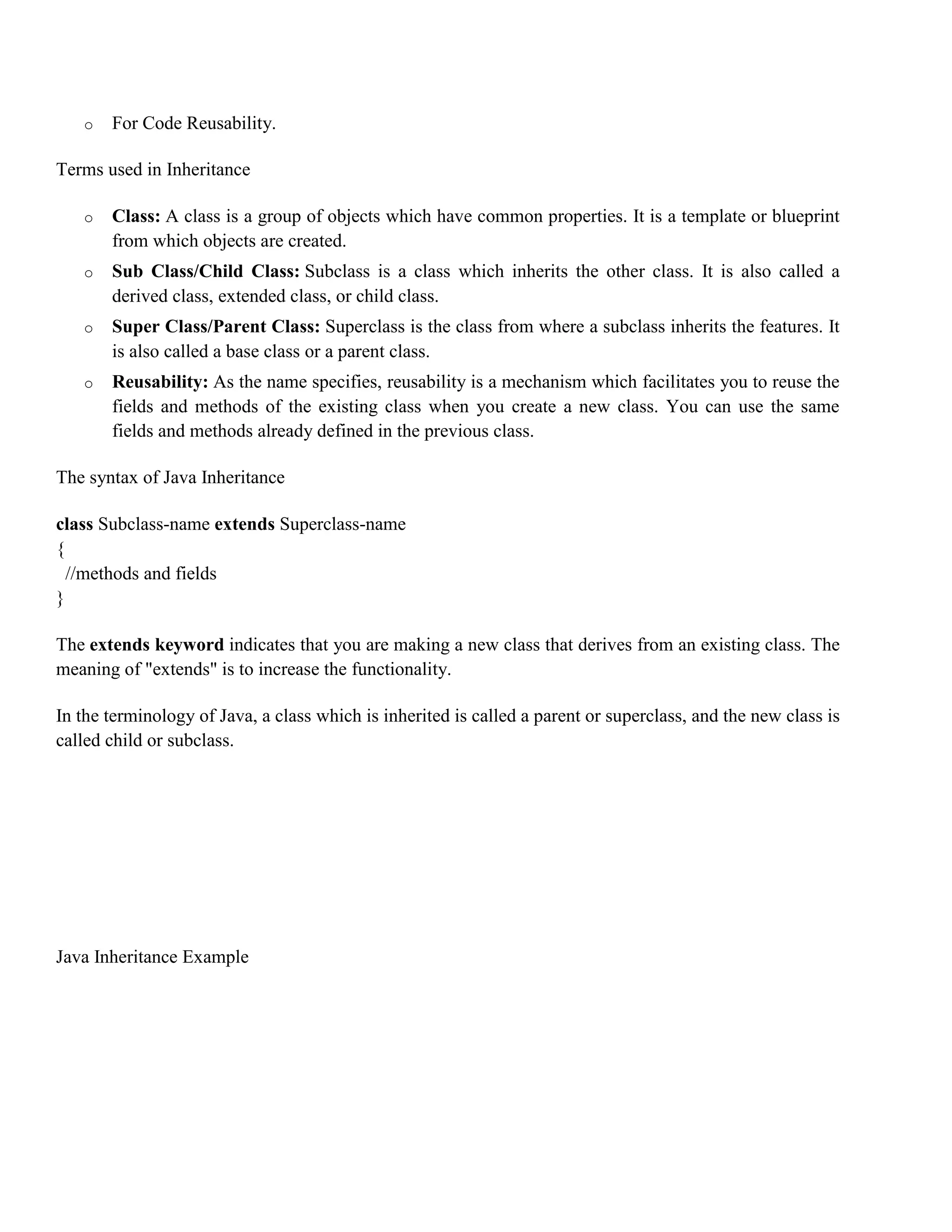
![As displayed in the above figure, Programmer is the subclass and Employee is the superclass. The relationship between the two classes is Programmer IS-A Employee. It means that Programmer is a type of Employee. class Employee{ float salary=40000; } class Programmer extends Employee{ int bonus=10000; public static void main(String args[]){ Programmer p=new Programmer(); System.out.println("Programmer salary is:"+p.salary); System.out.println("Bonus of Programmer is:"+p.bonus); } } Test it Now Programmer salary is:40000.0 Bonus of programmer is:10000 In the above example, Programmer object can access the field of own class as well as of Employee class i.e. code reusability. Types of inheritance in java On the basis of class, there can be three types of inheritance in java: single, multilevel and hierarchical. In java programming, multiple and hybrid inheritance is supported through interface only. We will learn about interfaces later.](https://image.slidesharecdn.com/javafull-231001024002-6ff00f11/75/java-full-docx-45-2048.jpg)
![Note: Multiple inheritance is not supported in Java through class. When one class inherits multiple classes, it is known as multiple inheritance. For Example: Single Inheritance Example When a class inherits another class, it is known as a single inheritance. In the example given below, Dog class inherits the Animal class, so there is the single inheritance. TestInheritance.java class Animal{ void eat(){System.out.println("eating...");} } class Dog extends Animal{ void bark(){System.out.println("barking...");} } class TestInheritance{ public static void main(String args[]){ Dog d=new Dog(); d.bark(); d.eat();](https://image.slidesharecdn.com/javafull-231001024002-6ff00f11/75/java-full-docx-46-2048.jpg)
![}} Output: barking... eating... Multilevel Inheritance Example When there is a chain of inheritance, it is known as multilevel inheritance. As you can see in the example given below, BabyDog class inherits the Dog class which again inherits the Animal class, so there is a multilevel inheritance. class Animal{ void eat(){System.out.println("eating...");} } class Dog extends Animal{ void bark(){System.out.println("barking...");} } class BabyDog extends Dog{ void weep(){System.out.println("weeping...");} } class TestInheritance2{ public static void main(String args[]){ BabyDog d=new BabyDog(); d.weep(); d.bark(); d.eat(); }} Output: weeping... barking... eating... Hierarchical Inheritance Example When two or more classes inherits a single class, it is known as hierarchical inheritance. In the example given below, Dog and Cat classes inherits the Animal class, so there is hierarchical inheritance. TestInheritance3.java](https://image.slidesharecdn.com/javafull-231001024002-6ff00f11/75/java-full-docx-47-2048.jpg)
![class Animal{ void eat(){System.out.println("eating...");} } class Dog extends Animal{ void bark(){System.out.println("barking...");} } class Cat extends Animal{ void meow(){System.out.println("meowing...");} } class TestInheritance3{ public static void main(String args[]){ Cat c=new Cat(); c.meow(); c.eat(); //c.bark();//C.T.Error }} Output: meowing... eating... Q) Why multiple inheritance is not supported in java? To reduce the complexity and simplify the language, multiple inheritance is not supported in java. Consider a scenario where A, B, and C are three classes. The C class inherits A and B classes. If A and B classes have the same method and you call it from child class object, there will be ambiguity to call the method of A or B class. Since compile-time errors are better than runtime errors, Java renders compile-time error if you inherit 2 classes. So whether you have same method or different, there will be compile time error. class A{ void msg(){System.out.println("Hello");} } class B{ void msg(){System.out.println("Welcome");} } class C extends A,B{//suppose if it were](https://image.slidesharecdn.com/javafull-231001024002-6ff00f11/75/java-full-docx-48-2048.jpg)
![public static void main(String args[]){ C obj=new C(); obj.msg();//Now which msg() method would be invoked? } } Test it Now Compile Time Error Method Overriding Method Overloading and Method Overriding are the topics that should be on your to-do list before appearing for the interview. In this post, I will share what is method overriding, the rules of method overriding, and examples. So let's dive in and understand method overriding in java. What is Method Overriding When the child class(subclass) has the method which has the same name, same parameters and same return type (or covariant return type) as a method in its parent class(or super-class), then the child method has overridden the parent class method. Runtime polymorphism can be achieved through method overriding. Remember that at runtime, Object type (not reference variable's type) determines which overridden method is used. If the parent class object is used to invoke the method, then the parent class method will be executed. Otherwise, if, a child class object is used to invoke the method, then the child class method will be executed. Example of Method Overriding](https://image.slidesharecdn.com/javafull-231001024002-6ff00f11/75/java-full-docx-49-2048.jpg)
![// Method Overriding Example //Base class class Parent { public void display() { System.out.println("parent method is executed"); }} //Derived or Inherited class class Child extends Parent { //Below method overrides the Parent display() method @Override public void display() { System.out.println("child method is executed"); }} //Driver class public class MethodOverriding1 { public static void main(String args[]) { // If a Parent type reference refers // to a Parent object, then Parent's // display() is called Parent parentObject = new Parent(); parentObject.display(); // If a Parent type reference refers // to a Child object Child's display() // is called. This is called RUN TIME // POLYMORPHISM. Parent childObject = new Child(); childObject.display(); }} Output: parent method is executed child method is executed RULES FOR METHOD OVERRIDING IN JAVA 1. ACCESS MODIFIERS AND OVERRIDING](https://image.slidesharecdn.com/javafull-231001024002-6ff00f11/75/java-full-docx-50-2048.jpg)

![// Access Modifiers and Overriding Example //Base class class Parent { //Access modifier of parent's display() method is protected protected void display() { System.out.println("parent method is executed"); } } //Derived class class Child extends Parent { //Below method overrides the Parent display() method //Access modifier public is less restrictive than protected @Override public void display() { System.out.println("child method is executed"); } } //Driver class public class MethodOverriding2 { public static void main(String args[]) { Parent parentObject = new Parent(); parentObject.display(); Parent childObject = new Child(); childObject.display(); }} Output : parent method is executed child method is executed 2. Private methods can not be overridden Another rule regarding access modifiers is you can not override private methods in the parent class. If subclass tries to override the private method of a parent class then the program will throw a compile-time error as shown below. // Access Modifiers and Overriding Example //Base class or Superclass](https://image.slidesharecdn.com/javafull-231001024002-6ff00f11/75/java-full-docx-52-2048.jpg)
![class Parent { //Access modifier of parent method is private // This method can not override the child class method private void display() { System.out.println("parent method is executed"); } } //Derived class or Subclass class Child extends Parent { //Below method can not overrides the Parent display() method //This method is unique to the child class private void display() { System.out.println("child method is executed"); } } //Driver class public class MethodOverriding3 { public static void main(String args[]) { Parent parentObject = new Parent(); parentObject.display(); // this line when execute will throw compiler error Parent childObject = new Child(); childObject.display(); // this line when execute will throw compiler error } } 3. FINAL METHODS CAN NOT BE OVERRIDDEN IN JAVA You can not override a method marked final. It will throw a compile-time error if you try to do so. // Simple Java program showing // final methods cannot be overridden //Parent class or Superclass class Parent {](https://image.slidesharecdn.com/javafull-231001024002-6ff00f11/75/java-full-docx-53-2048.jpg)

![//Derived class or SubClass class Child extends Parent { //This method hides the Parent display() method static void display() { System.out.println("child static method is executed"); } // This method overrides the Parent show() method void show() { System.out.println("child non-static (instance) method is executed"); } } //Driver Class public class MethodOverriding4 { public static void main(String args[]) { Parent childObject = new Child(); // static method can not be overridden, // so below line calls parent display() method childObject.display(); // Expected child method will run childObject.show(); } } Output: parent static method is executed child non-static (instance) method is executed 5. Invoking a superclass (Parent class) version of overridden method It's easy to call the superclass(Parent class) version of overridden method by using the super keyword. // Invoking SuperClass version of Overridden Method Example //Base class or SuperClass class Parent { void display() {](https://image.slidesharecdn.com/javafull-231001024002-6ff00f11/75/java-full-docx-55-2048.jpg)
![System.out.println("parent method is executed"); } } //Derived class or SubClass class Child extends Parent { //This method overrides the Parent display() method @Override void display() { super.display(); System.out.println("child method is executed"); } } public class MethodOverriding5 { public static void main(String args[]) { Parent childObject = new Child(); childObject.display(); } } Output : parent method is executed child method is executed 6. Overriding method must have the same return type (or Covariant return type) The method return type must be the same, or a subtype of, the return type declared in the original overridden method in the superclass. Since java 5.0 it is made possible to have a different return type for an overriding method in a child class. But child's return type should be a subtype of the parent's return type. This phenomenon is called covariant return type. Example of Covariant Return Type class Alpha { Alpha doStuff(char c) { return new Alpha();](https://image.slidesharecdn.com/javafull-231001024002-6ff00f11/75/java-full-docx-56-2048.jpg)
![} } class Beta extends Alpha { Beta doStuff(char c) { // legal override in Java 1.5 return new Beta(); } } public class MethodOverriding6 { public static void main(String args[]) { Alpha childObject = new Beta(); childObject.doStuff('a'); } } The above code will compile and run. 7. CONSTRUCTOR AND OVERRIDING You can not override the constructor as the constructor name of the base class and child class can never be the same. (Constructor name is always the same as the class name). 8. Exception Handling and Overriding Rule 1. The overriding method can throw any unchecked(runtime) exception regardless of whether the overridden method declares the exception. // Overriding when superclass does not throw an exception //Base class or SuperClass class Parent { //overridden method void display() { System.out.println("parent method is executed"); } } //Derived class or SubClass](https://image.slidesharecdn.com/javafull-231001024002-6ff00f11/75/java-full-docx-57-2048.jpg)
![class Child extends Parent { //This method overrides the Parent display() method //It throws unchecked exception i.e Arithmetic Exception @Override void display() throws ArithmeticException{ System.out.println("child method is executed"); } } public class MethodOverriding7 { public static void main(String args[]) { Parent childObject = new Child(); childObject.display(); } } Output: child method is executed Rule 2. The overriding method must not throw checked exceptions that are new or broader than those declared by the overridden method. For example, a method that declares a FileNotFoundException can not be overridden by a method that declares a SQLException, Exception, or any other non-runtime exception unless it's a subclass of FileNotFoundException. Note : The overriding method can throw narrower or fewer exceptions. Just because an overridden method "takes risks" doesn't mean that the overriding subclass' exception takes the same risks. Bottom line: an overriding method doesn't have to declare any exceptions that it will never throw, regardless of what the overridden method declares. 9. Abstract method and Overriding Abstract methods can only be overridden by the first concrete class (classes that have no abstract methods) otherwise a compiler error will be thrown. //Abstract class abstract class Parent { public abstract void display( int x, String j);](https://image.slidesharecdn.com/javafull-231001024002-6ff00f11/75/java-full-docx-58-2048.jpg)
![} //Subclass or Derived Class class Child extends Parent { @Override public void display( int x, String j ) { System.out.println("child method is executed"); } } //Driver class public class MethodOverriding8 { public static void main(String args[]) { Parent childObject = new Child(); childObject.display(1, "Alive is Awesome"); } } Output : child method is executed 10. SYNCHRONIZED/STRICTFP METHOD AND OVERRIDING Synchronized or strictfp methods do not have any impact on the overriding method. It's possible that a non-synchronized or non-strictfp method can override a synchronized/strictfp method or vice versa. MultiLevel Method Overriding in Java In the multilevel method overriding we create a grandchild class and override the display() method of the parent class. Let's find out what will happen if we perform runtime polymorphism in multilevel overriding. // MultiLevel Overriding //Base class or SuperClass class Parent { //overridden method void display() {](https://image.slidesharecdn.com/javafull-231001024002-6ff00f11/75/java-full-docx-59-2048.jpg)
![System.out.println("parent method is executed"); } } //Derived class or SubClass class Child extends Parent { //This method overrides the Parent display() method @Override void display() { System.out.println("child method is executed"); } } //Inherited Class class GrandChild extends Child { // This method overrides the Parent display() method @Override void display() { System.out.println("grand child method is executed"); } } //Driver Class public class MethodOverriding9 { public static void main(String args[]) { Parent grandchildObject = new GrandChild(); grandchildObject.display(); } } Output: grand child method is executed EXAMPLES OF LEGAL/ILLEGAL METHOD OVERRIDES Let's have a simple class Animal with the eat() method.](https://image.slidesharecdn.com/javafull-231001024002-6ff00f11/75/java-full-docx-60-2048.jpg)

